BETHANGA BRIDGE
TALGARNO ROAD BELLBRIDGE AND BETHANGA, TOWONG SHIRE (PARTIALLY IN NSW)
-
Add to tour
You must log in to do that.
-
Share
-
Shortlist place
You must log in to do that.
- Download report


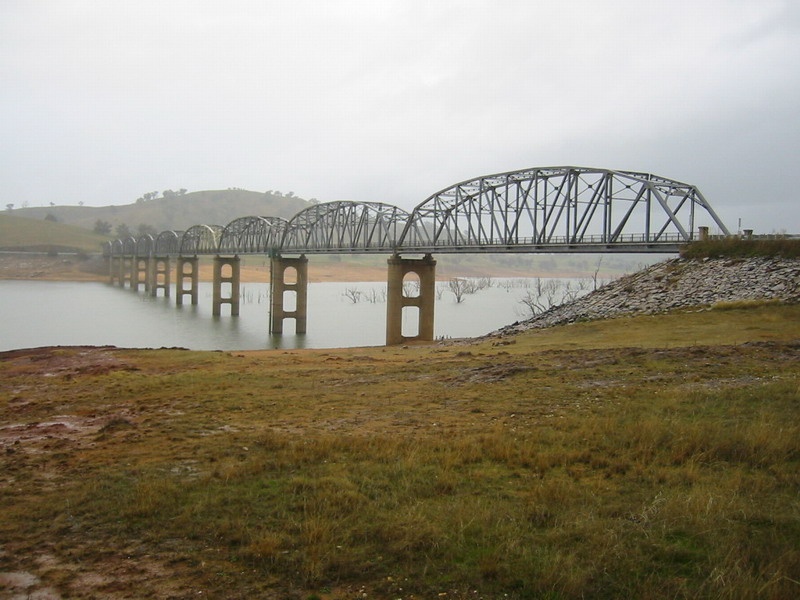
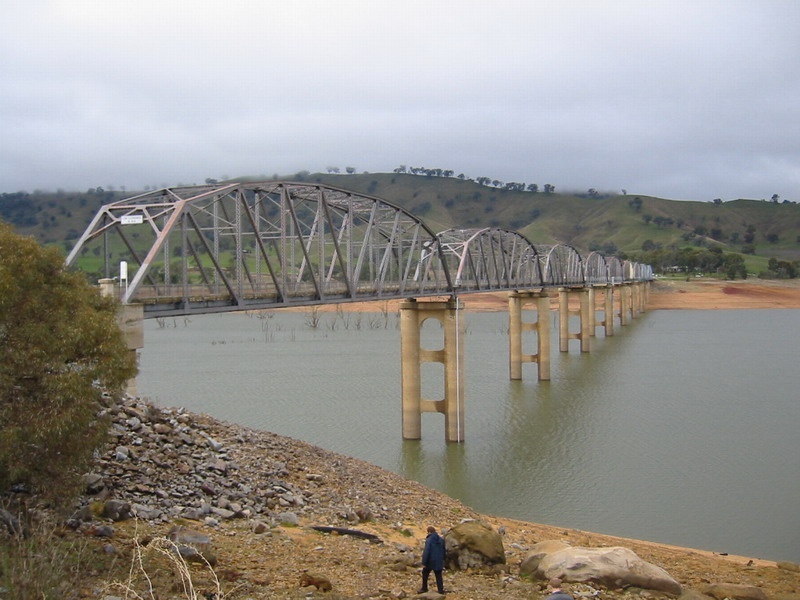
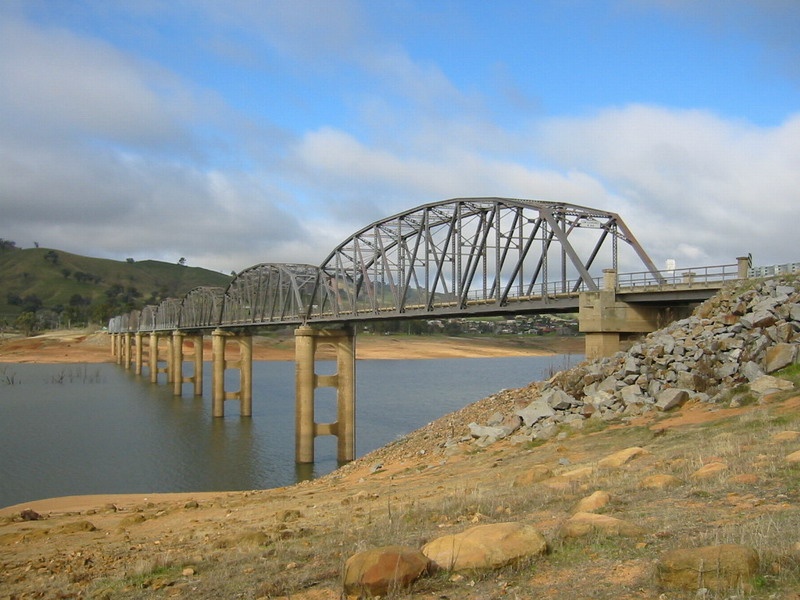
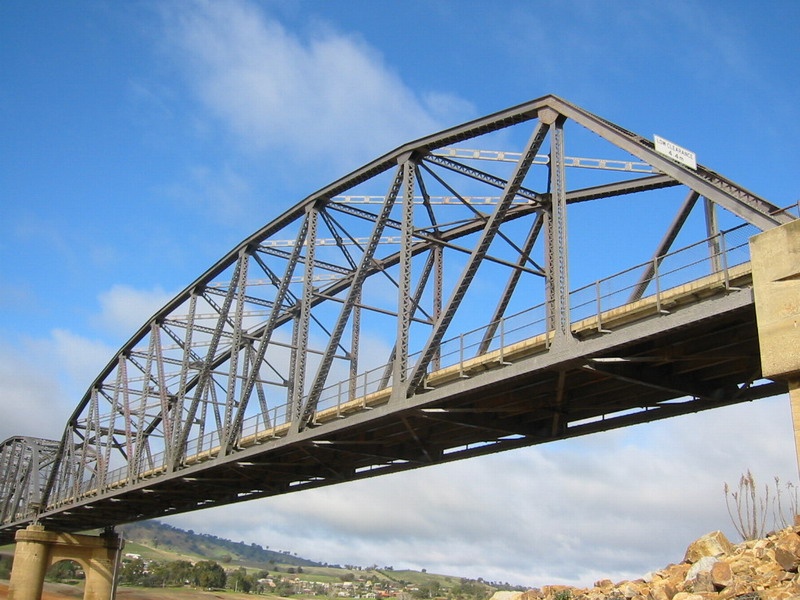
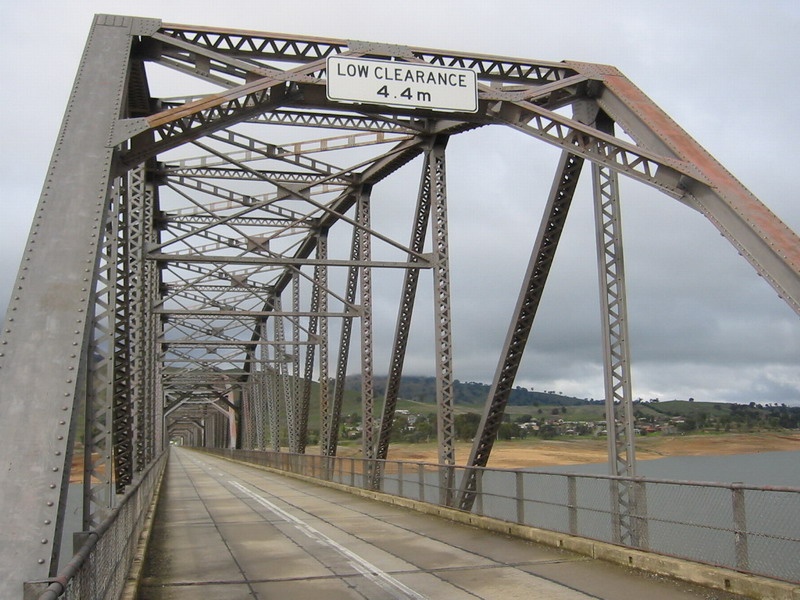

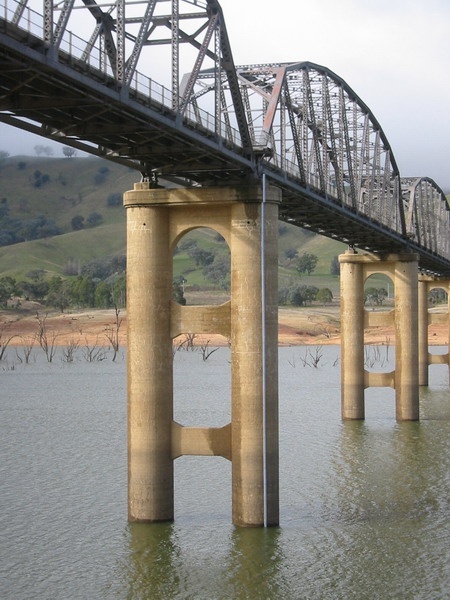
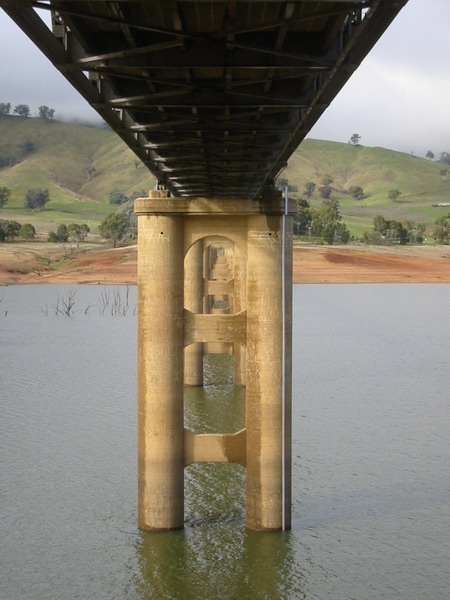
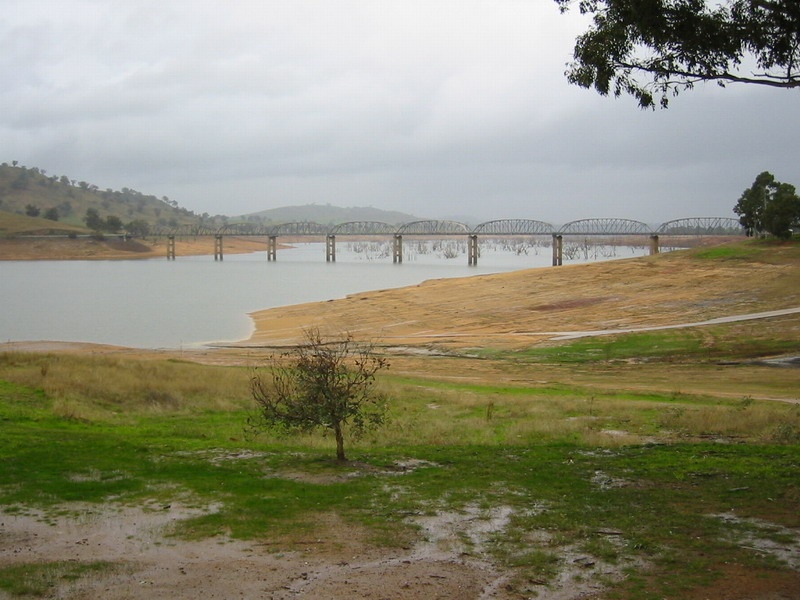
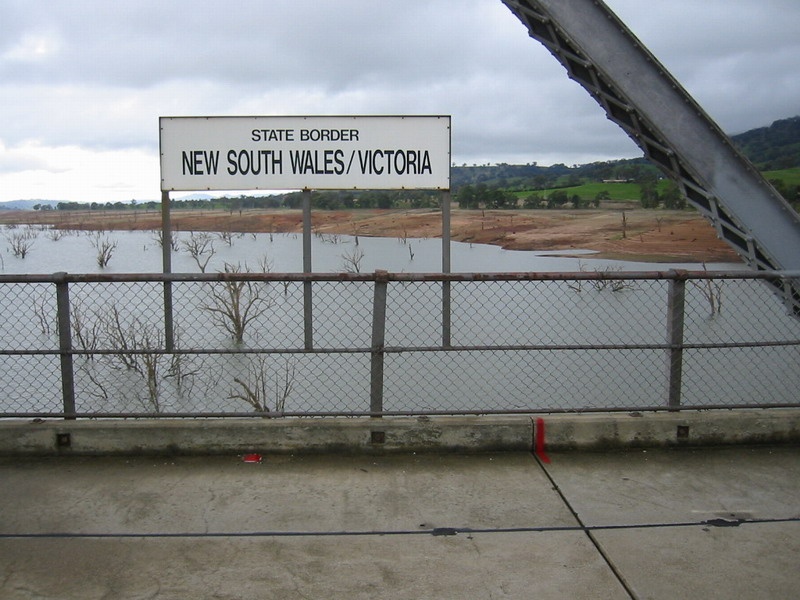
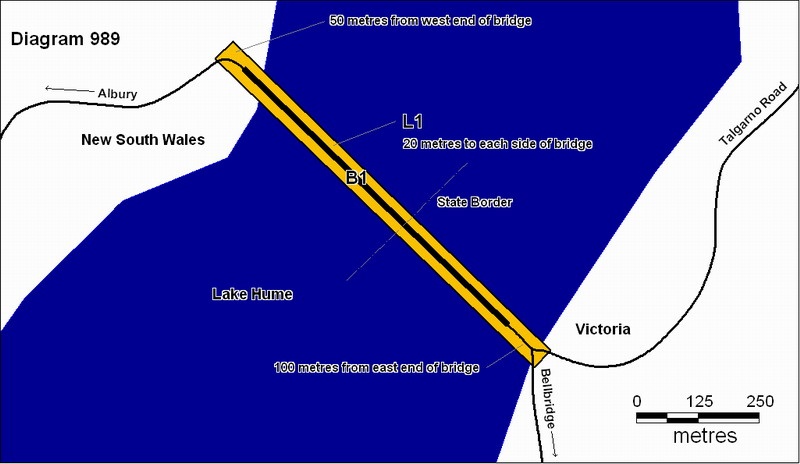
Statement of Significance
The Bethanga Bridge, was built between 1927 and 1930 as a joint venture between New South Wales and Victoria as part of the Hume Dam project and as a key element of the River Murray Waters Agreement.The Agreement was put in place in 1915 by the Victorian, New South Wales, South Australian and Federal governments to regulate the flow of the Murray River as a provision against drought and to ensure that the three states received their agreed share of water. The River Murray Commission was created to manage the task of putting the agreement into effect.
The Bethanga Bridge is a road bridge over a flooded section of a Murray River valley that now forms part of the Hume Dam. The bridge consists of nine spans of 82 metres, each span being supported between double reinforced concrete pylons by a riveted steel camel back Pratt truss plus a 14 metre approach span on the New South Wales side. The overall span is 752 metres. The road deck was initially timber but was replaced in 1961 with the current concrete waffle slab deck. The road deck is 7.7 metres wide. In 1961 the bridge deck and truss structure was also raised by 300mm in response to the upgrading of Hume Dam and works to increase the storage capacity of the dam.
The use of Pratt trusses is unusual in Victoria, not being readily taken up as a viable bridge design. However they are more common in New South Wales. The use of the Pratt truss in this instance reflects the mode of construction employed during the construction of the Hume Dam whereby the New South Wales Department of Public Works and the Victorian State Rivers and Water Supply Commission were jointly responsible for the design and construction of the bridge. The bridge was designed in New South Wales by Department of Main Roads engineer Percy Allen and the trusses were built by Vickers Ruwolt in Melbourne.
The Murray River border between New South Wales and Victoria is the top of the southern bank of the river. As such all structures over the river are generallyconsidered to be in New South Wales. However, because of its unique location, over the waters of a dam with the border running down the centre of the body of water, the Bethanga bridge is the only built structure shared by both New South Wales and Victoria.
How is it Significant?
Bethanga Bridge is of historical and scientific (technical) significance to the State of Victoria
Why is it Significant?
Bethanga Bridge is of historical significance to the State of Victoria for its associations with the construction of Hume Dam. It is also of historical significance for its associations with the River Murray Waters Agreement and the River Murray Commission.
-
-
BETHANGA BRIDGE - History
Built 1927-30; raised and strengthened 1961; new deck ("waffle slab") 1970.
BETHANGA BRIDGE - Permit Exemptions
General Exemptions:General exemptions apply to all places and objects included in the Victorian Heritage Register (VHR). General exemptions have been designed to allow everyday activities, maintenance and changes to your property, which don’t harm its cultural heritage significance, to proceed without the need to obtain approvals under the Heritage Act 2017.Places of worship: In some circumstances, you can alter a place of worship to accommodate religious practices without a permit, but you must notify the Executive Director of Heritage Victoria before you start the works or activities at least 20 business days before the works or activities are to commence.Subdivision/consolidation: Permit exemptions exist for some subdivisions and consolidations. If the subdivision or consolidation is in accordance with a planning permit granted under Part 4 of the Planning and Environment Act 1987 and the application for the planning permit was referred to the Executive Director of Heritage Victoria as a determining referral authority, a permit is not required.Specific exemptions may also apply to your registered place or object. If applicable, these are listed below. Specific exemptions are tailored to the conservation and management needs of an individual registered place or object and set out works and activities that are exempt from the requirements of a permit. Specific exemptions prevail if they conflict with general exemptions. Find out more about heritage permit exemptions here.Specific Exemptions:General Conditions: 1.
All exempted alterations are to be planned and carried out in a manner which prevents damage to the fabric of the registered place or object. General Conditions: 2.
Should it become apparent during further inspection or the carrying out of works that original or previously hidden or inaccessible details of the place or object are revealed which relate to the significance of the place or object, then the exemption covering such works shall cease and the Executive Director of Heritage Vicroria shall be notified as soon as possible. Note: All archaeological places have the potential to contain significant sub-surface artefacts and other remains. In most cases it will be necessary to obtain approval from Heritage Victoria before the undertaking any works that have a significant sub-surface component. General Conditions: 3.
If there is a conservation policy and plan approved by the Executive Director, all works shall be in accordance with it. Note: The existence of a Conservation Management Plan or a Heritage Action Plan endorsed by Heritage Victoria provides guidance for the management of the heritage values associated with the site. It may not be necessary to obtain a heritage permit for certain works specified in the management plan. General Conditions: 4.
Nothing in this determination prevents the Executive Director from amending or rescinding all or any of the permit exemptions. General Conditions: 5.
Nothing in this determination exempts owners or their agents from the responsibility to seek relevant planning or building permits from the responsible authorities where applicable. Regular Site Maintenance :
The following site maintenance works are permit exempt under section 66 of the Heritage Act 1995, a) regular site maintenance provided the works do not involve the removal or destruction of any significant above-ground features or sub-surface archaeological artefacts or deposits; b) the maintenance of an item to retain its conditions or operation without the removal of or damage to the existing fabric or the introduction of new materials; c) cleaning including the removal of surface deposits, organic growths, or graffiti by the use of low pressure water and natural detergents and mild brushing and scrubbing; d) repairs, conservation and maintenance to plaques, memorials, roads and paths, fences and gates and drainage and irrigation. e) the replacement of existing services such as cabling, plumbing, wiring and fire services that uses existing routes, conduits or voids, and does not involve damage to or the removal of significant fabric. Note: Surface patina which has developed on the fabric may be an important part of the item’s significance and if so needs to be preserved during maintenance and cleaning. Note: Any new materials used for repair must not exacerbate the decay of existing fabric due to chemical incompatibility, obscure existing fabric or limit access to existing fabric for future maintenance. Repair must maximise protection and retention of fabric and include the conservation of existing details or elements. Public Safety and Security :
The following public safety and security activities are permit exempt under section 66 of the Heritage Act 1995, a) public safety and security activities provided the works do not involve the removal or destruction of any significant above-ground structures or sub-surface archaeological artefacts or deposits; b) the erection of temporary security fencing, scaffolding, hoardings or surveillance systems to prevent unauthorised access or secure public safety which will not adversely affect significant fabric of the place including archaeological features; c) development including emergency stabilisation necessary to secure safety where a site feature has been irreparably damaged or destabilised and represents a safety risk to its users or the public. Note: Urgent or emergency site works are to be undertaken by an appropriately qualified specialist such as a structural engineer, or other heritage professional. Signage and Site Interpretation :
The following Signage and Site Interpretation activities are permit exempt under section 66 of the Heritage Act 1995, a) signage and site interpretation activities provided the works do not involve the removal or destruction of any significant above-ground structures or sub-surface archaeological artefacts or deposits; b) the erection of non-illuminated signage for the purpose of ensuring public safety or to assist in the interpretation of the heritage significance of the place or object and which will not adversely affect significant fabric including landscape or archaeological features of the place or obstruct significant views of and from heritage values or items; c) signage and site interpretation products must be located and be of a suitable size so as not to obscure or damage significant fabric of the place; d) signage and site interpretation products must be able to be later removed without causing damage to the significant fabric of the place; Note: The development of signage and site interpretation products must be consistent in the use of format, text, logos, themes and other display materials. Note: Where possible, the signage and interpretation material should be consistent with other schemes developed on similar or associated sites. It may be necessary to consult with land managers and other stakeholders concerning existing schemes and strategies for signage and site interpretation. Minor Works :
Note: Any Minor Works that in the opinion of the Executive Director will not adversely affect the heritage significance of the place may be exempt from the permit requirements of the Heritage Act. A person proposing to undertake minor works may submit a proposal to the Executive Director. If the Executive Director is satisfied that the proposed works will not adversely affect the heritage values of the site, the applicant may be exempted from the requirement to obtain a heritage permit. If an applicant is uncertain whether a heritage permit is required, it is recommended that the permits co-ordinator be contacted.Painting:
Painting will not require permit approval if the painting: a) does not involve the disturbance or removal of earlier paint layers other than that which has failed by chalking, flaking, peeling or blistering; b) involves over-coating with an appropriate surface as an isolating layer to provide a means of protection for significant earlier layers or to provide a stable basis for repainting; c) employs the same colour scheme and paint type as an earlier scheme if they are appropriate to the substrate and do not endanger the survival of earlier paint layers.
If the painting employs a different colour scheme and paint type from an earlier scheme a permit will not be required if a) the Executive Director is satisfied that the proposed colour scheme, paint type, details of surface preparation and paint removal will not adversely affect the heritage significance of the item; b) the person proposing to undertake the painting has received a notice advising that the Executive Director is satisfied.
If the painting employs a different colour scheme and paint type from an earlier scheme a permit will not be required if a) the Executive Director is satisfied that the proposed colour scheme, paint type, details of surface preparation and paint removal will not adversely affect the heritage significance of the item; b) the person proposing to undertake the painting has received a notice advising that the Executive Director is satisfied. Any proposal to undertake such work should be submitted to the Executive Director, detailing the proposed colour scheme, paint type, details of surface preparation and paint removal involved in the repainting, for approval.Road Works
The following works to the road portion of the place is permit exempt: a)The resurfacing of the road and maintenance to the road surface; b) lane marking; c) erection of speed and traffic signs.
The installation of traffic lights may be permit exemptif the Executive Director is satisfied that the heritage significance and the significant fabric of the place will not be adversely affected by such an installation. Any proposal to undertake such work should be submitted to the Executive Director for approval.BETHANGA BRIDGE - Permit Exemption Policy
It is the purpose of the permit exemptions to enable routine maintenance and repairs which do not damage the significant fabric of the place, or diminish its cultural significance.
It should be noted that as theplace is also registered in New South Wales so any permit issued must be approved by both the New South Wales Heritage Office and Heritage Victoria. It should also be noted that permit exemptions only apply if they are issued by both Heritage Victoria and the New South Wales Heritage Office.
Bethanga Bridge is significant for the method of its construction. Any proposed works that would replace or alter the fabric of the structure, or adversely affect any understanding of it, particularly that of the Pratt trusses, should be avoided.
-
-
-
-
-
BETHANGA BRIDGE
 Victorian Heritage Register H0989
Victorian Heritage Register H0989 -
Bethanga Bridge over Hume Weir (Murray Arm)
 National Trust H0989
National Trust H0989
-
'YARROLA'
 Boroondara City
Boroondara City -
1 Bradford Avenue
 Boroondara City
Boroondara City
-
-










